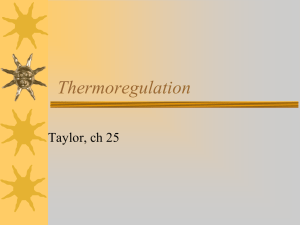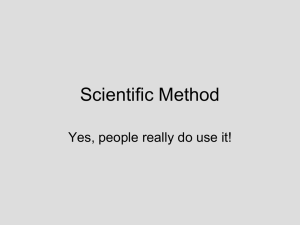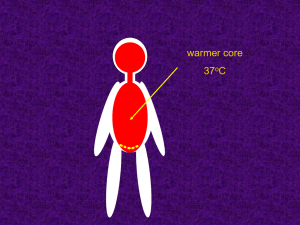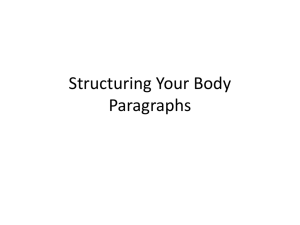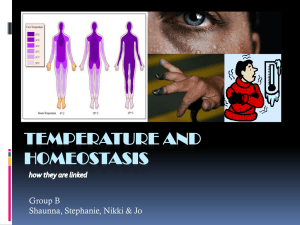Induced normothermia in icu patients with neurologic insult
advertisement
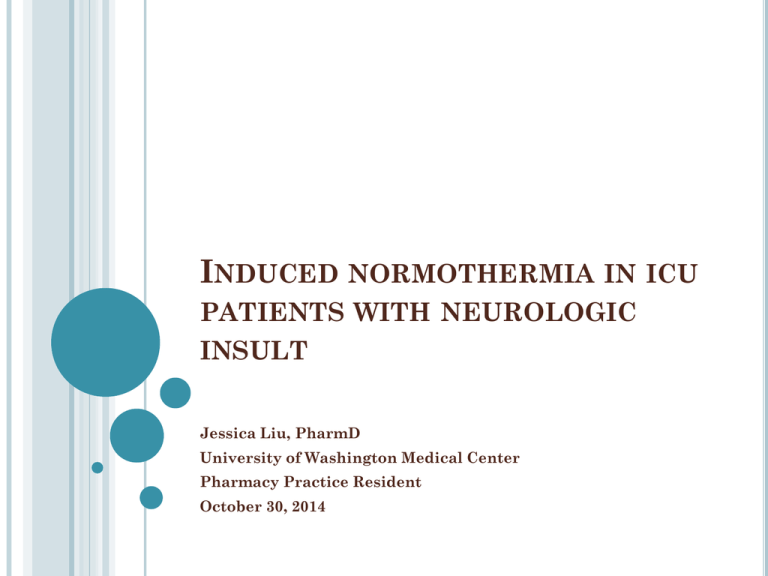
INDUCED NORMOTHERMIA IN ICU PATIENTS WITH NEUROLOGIC INSULT Jessica Liu, PharmD University of Washington Medical Center Pharmacy Practice Resident October 30, 2014 CONCEPT OF NORMOTHERMIA Prevention of Secondary Brain Injury Can occur hours to days after primary injury (ex: stroke, trauma, intracranial hemorrhage, infection, seizure, delayed perfusion) Damage caused by inflammation, edema, fever Idea that lowering body temperature may have a neuroprotectice effect, but how low do we go? CONCEPT OF NORMOTHERMIA Fever has long been known to cause harm in severe acute neurologic injury, however, preliminary results in animal hypothermia and its potential benefit has provided mixed results Evidence that neuroprotective effects of hypothermia lessened due to inherent side effects (infection, shivering) “Aggressive treatment of fever in the ICU w/o risk elevation through the side effects of therapeutic hypothermia led to the concept of controlled prophylactic normothermia. This concept is based upon strict control of body core temperature with a target of 36.5°C beginning as early as possible with the goal of complete fever prevention.” (Broessner 2012) (Polderman 2009) GOALS OF DECREASING BODY TEMPERATURE Decrease cellular demand for O2 Stabilize the blood brain barrier Stabilize cell membranes Prevent ischemia, which in turn inhibits formation of reactive oxygen species, inflammatory cascades, and mitochondrial dysfunction TEMPERATURE MODULATING DEVICES Arctic Sun Cooling blanket www.allbiomedical.com www.medivance.com TEMPERATURE MODULATING DEVICES Cooling Catheter Bair Hugger www.solutions.3m.com www.medgadget.com CONSIDERATIONS OF TEMPERATURE MODULATION Fever Infection Shivering FEVERS ARE BAD NEWS… “Up to 90% of patients develop at least one febrile episode within 7 days after being admitted to the ICU.” (Marion 2004) Many pathophysiological mechanisms affected by fever: Free radical production Local thermopooling Disruption of blood brain barrier Increased intracranial pressure Increased enzymatic inhibition of protein kinases Increased metabolic demand STUDIES SHOW FEVERS ASSOCIATED WITH WORSE OUTCOMES IN BRAIN INJURIES “Impact of fever on outcome in patients with stroke and neurologic injury: a comprehensive meta-analysis” (Greer, Stroke 2008) Comprehensive meta-analysis of all studies addressing fever in brain-injured patients Studies pulled from Medline articles published since January 1, 1995 Pooled analyses indentified 39 studies covering 14,431 patients Study outcomes included fever/higher body temperature and normothermia/lower body temperature STUDIES SHOW FEVERS ASSOCIATED WITH WORSE OUTCOMES IN BRAIN INJURIES Relative risk of worse outcome with fever: Mortality 1.5 Glasgow Outcome Scale 1.3 Barthel Index 1.9 Modified Rankin Scale 2.2 Canadian Stroke Scale 1.4 Intensive Care LOS 2.8 Hospital LOS 3.2 In all 7 outcome measures, meta-analysis indicates fever associated with worse outcomes regardless of the type of neurological insult (ischemia, hemorrhagic, traumatic) ANTIPYRETICS & FEVER MANAGEMENT Acetaminophen the preferred agent (Kasner 2002) Inhibits cyclooxygenase-mediated prostaglandin synthesis to lower hypothalamic set point 650mg-1000mg Q4-6h (max 4g/day) can cause a small reduction in core body temperature and help promote hypothermia Key agent in achieving thermoregulation in stroke patients INFECTION RISKS WITH FEVER CONTROL Why do we get fevers? Pyrogens are produced by the body in response to an infection pyrogens bind to receptors on the hypothalamus binding signals the body to increase body temperature increase in temperature thought to help kill off infection INFECTION RISKS WITH FEVER CONTROL Aggressive fever control may actually cause more harm Bicenter, prospective, randomized trial comparing conventional fever control vs. aggressive fever control (Broessner, et al. Stroke. 2009) CFC temperature goal: T ≤ 37.9°C AFC temperature goal: T = 36.5°C Median total fever burden significantly higher in CFC group (4.3°C vs. 0.0°C, P <0.0001) Infectious complications higher in AFC group (94% vs. 78%) However, no difference in major adverse effects including: sepsis, bacteremia, and cerebral edema Unnecessary antibiotic use? Antibiotic associated problems? BENEFIT OF FEVER CONTROL REMAINS UNCLEAR… Prospective, randomized trial to assess influence of prophylactic, endovascularly based normothermia vs. conventional temperature management on inflammatory parameters in patients with severe cerebrovascular disease (Broessner, et al. Stroke. 2010) Study found no difference in patients’ neurological outcomes 6 months post endovascular cooling treatment “Although fever has been identified to be an independent predictor and risk factor of unfavorable outcome, especially in patients with severe neurological disease, many studies have consistently failed to ameliorate outcome by inducing normoor hypothermia…the inflammatory response might be negatively altered through thermoregulatory measures possibly nullifying a potential benefit of normothermia.” IMPORTANCE OF SHIVER CONTROL Shivering is the body’s physiological attempt to retain heat. Vasoconstriction occurs and blood is shunted away from the body’s extremities. Motor response begins in the trunk and spreads to extremities to generate heat Shivering occurs when the body’s temperature falls 1°C below the vasoconstriction threshold (Sessler 2009) Downside basal metabolic rate 5x normal energy expenditure, O2 consumption, CO2 production, and free radical formation Retard cooling process as heat transferred from core to periphery Cerebral metabolic stress Tachycardia, HTN ASSESS FOR SHIVERING Bedside Shivering Assessment Scale (BSAS) Palpate masseter, pectorals, deltoids, and quadriceps muscles Q1H 0 = no shivering 1 = mild shivering localized to neck and/or chest 2 = shivering involving neck and/or chest and arms 3 = intermittent generalized shivering involving all 4 extremities 4 = generalized, sustained, rigorous shivering Goal ≤ 1 Badjatia, et al. Stroke 2008 SHIVER MEDICATION MANAGEMENT Goal: to obtain shivering control with the least sedating regimen possible No sedation: acetaminophen, buspirone, magnesium sulfate, skin counterwarming Mild sedating agents: fentanyl, meperidine, dexmedetomidine Moderate sedation: opioids in combination with dexmedetomidine Heavy sedation: propofol Neuromuscular blockade: vercuronium BUSPIRONE & MEPERIDINE ACT SYNERGISTICALLY Buspirone Acts on 5HT1A receptor to lower threshold Meperidine Acts on an α2B adrenoreceptor subtype Experimental trial in 8 volunteers over 4 randomly-assigned days in 4 categories (Mokhtarani 2001): 1. Large dose oral buspirone (60mg) 2. Large dose IV meperidine (0.8 microgram/mL) 3. Buspirone (30mg) + meperidine (0.4 microgram/mL) 4. Control day with no drugs Results: minimal sedation with either drug or in combination Buspirone alone had little affect on shiver reduction Combo of low dose buspirone and meperidine acted synergistically to provide a significant reduction in shivering COLUMBIA ANTISHIVERING PROTOCOL FUTURE QUESTIONS TO ASK: When to initiate normothermia? Optimal length of therapy? Optimal target temperature? Optimizing medications for fever, shivering, and infections. Does the type of traumatic brain injury matter? Differences in surface vs. endovascular cooling? FUTURE CLINICAL TRIALS If normothermia is going to become more mainstream in the critical care of neurology patients, there needs to be a strong push for prospective, randomized, control trials. Current ongoing trial: “Normothermia Protocol for Traumatic Brain Injury Patients” Prospective, observational, outcome study Study start date: May 2011 Estimated completion date: May 2013 Estimated Enrollment: 80 patients Primary outcome measures: Effectiveness of normothermia protocol x 5 days Temperature vs. ICP Neurologic outcome Secondary Outcome Measure: mortality (in-hospital, 3-6 months) Sponsor: Medivance, Inc. CONCLUSION Body cooling in theory appears beneficial, but more studies are needed to support its use in clinical practice Infection can be a serious complication of decreased body temperature Prolonged treatment periods may be required Adequate management of potential side effects is essential REFERENCES "Normothermia Protocol For Traumatic Brain Injury Patients". Clinicaltrials.gov. Published May 12, 2011. Accessed September 22, 2013. http://clinicaltrials.gov/show/NCT01354509 Broessner G, Beer R, Lackner P, et al.: "Prophylactic, endovascularly based, long-term normothermia in ICU patients with severe cerebrovascular disease: bicenter prospective, randomized trial". Stroke 2009, 40:e657-e665. Broessner G, Lackner P, Fischer M, et al.: "Influence of prophylactic, endovascularly based normothermia on inflammation in patient with severe cerebrovascular disease: a prospective, randomized trial". Stroke 2010, 41:29692972. Badjatia N, et al.: "Metabolic impact of shivering during therapeutic temperature modulation. The bedside shivering assessment scale". Stroke 2008, 39:3242-3247. Greer DM, Funk SE, Reaven NL, et al.: "Impact of fever on outcome in patients with stroke and neurologic injury: a comprehensive meta-analysis". Stroke 2008, 39:3029-3035. Sessler DI: "Thermoregulatory defense mechanisms". Critical Care Medicine 2009, 37(7 Suppl):S203-10. Broessner G, et al.: "Controlled prophylactic normothermia". Critical Care 2012, 16(Suppl 2):A10. Marion DW: "Controlled normothermia in neurologic intensive care". Critical Care Medicine 2004, 32(Suppl):S43-S45. Kasner SE, Wein T, Piriyawat P, et al.: "Acetaminophen for altering body temperature in acute stroke: a randomized clinical trial". Stroke 2002, 33:130-4. Mokhtarani M, Mahgoub AN, Morioka N, et al." "Buspirone and meperidine synergistically reduce the shivering threshold". Anesth Analg 2001, 93:1233-9. Polderman KH: “Mechanisms of action, physiological effects, and complications of hypothermia”. Critical Care Medicine 2009, 37(7 Suppl):S186-202.

